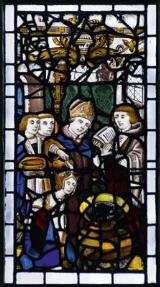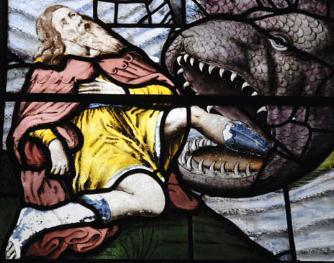

BCD Special Report on
Historic Churches
17th annual edition
3
adaptation of monastic churches for secular
cathedral or parochial use, as at Gloucester,
Tewkesbury and Great Malvern. But even
here there were casualties. At Tewkesbury,
for example, the monastic choir clerestory
windows may have been preserved as part
of the new parish church (title illustration),
but the redundant Lady Chapel was swept
away, its windows and monuments with it.
Te fate of the enormous Benedictine abbey
church of St Mary in York is more typical of
the fate of most monastic churches. It was
reduced to a ruin within only a few years
of its dissolution, leaving almost no traces
of its once extensive glazing scheme.
Although the windows of the parishes
and the secular cathedrals remained
largely untouched throughout Henry VIII’s
reign, in 1538 the King declared Tomas
Becket a traitor and decreed that images
of the saint be destroyed, which must have
occasioned the loss of some stained glass.
Te extensive early 16th-century Becket
cycle that once adorned the windows next
to a Becket altar in the parish church of
St Michael le Belfry next to York Minster
was probably one such target. Completed
only a few years before the prohibition that
caused their dismemberment, the windows
were based on the narrative in William
Caxton’s English translation of the Golden
Legend, containing exotic apocryphal detail
concerning the parentage of Becket (above).
Four panels can still be seen in St Michael
le Belfry and their survival in the church
is probably due to their similarity with the
depiction of the sacraments of baptism and
marriage. Of those panels removed from
St Michael’s, some were used at various times
to provide patch material for the repair of
windows at the Minster, the church’s neighbour
and patron. In 1959 the scenes that survived
this dismemberment were fnally relocated
to the east window of the Minster’s chapter
house. Te true identity of this intriguing
collection has only emerged in recent years.
In 1547, during the brief reign of Henry’s
son, Edward VI, imagery in windows was
specifcally singled out for scrutiny and
reformation for the frst time. Even so,
the high costs of re-glazing a large church
probably stayed the hand of many a reformer.
Only in the most stalwart citadels of
Protestantism were concerted eforts made
to strip the church of its medieval stained
glass. In Norwich, for example, several parish
churches spent large sums removing images
that were ‘contrary to the King’s majesty’s
injunctions’, while at Durham Cathedral
zealous reformer Dean Horne destroyed
the 15th-century cloister windows depicting
the life and miracles of St Cuthbert.
Elsewhere, those damaging stained glass
windows were prosecuted for their acts
and in York, with its Minster and its parish
churches full of medieval stained glass, very
little seems to have been done in response
to the Edwardian injunctions. A policy of
expediency was probably the order of the
day through most of England. Some glass
was removed and preserved against the day
when traditional religion was restored, while
elsewhere it was whitewashed to obscure
the most ‘problematic’ images – the stained
glass equivalent of knocking the head of a
statue. Even in Canterbury, with its extensive
Becket cycle, there was little appetite for
iconoclasm where the cathedral’s windows were
concerned. Becket’s glorious shrine was an
early casualty of reform, but little damage was
sustained to the glass until the 17th century.
After a brief return to Catholicism under
Queen Mary, the reign of Queen Elizabeth
witnessed a signifcant amount of restoration
in churches and cathedrals although by then
the number of skilled glaziers and glass-
painters had probably declined signifcantly.
At Salisbury Cathedral, for example, surviving
shields of arms dated 1569 attest to the
re-glazing that went on under Bishop Jewel
(Bishop of Salisbury from 1559 to 1571).
Under Elizabeth’s Stuart successors,
stained glass even enjoyed a revival of
popularity, although by now the techniques
employed relied less on the cutting, painting
and leading of coloured glass in a mosaic
combination and more on the application of
coloured enamel to large expanses of white
glass (below). Several of those closest to
Charles I were said to have admired medieval
stained glass, especially the windows in the
chapel of Te Vyne and the parish church of
Fairford in Gloucestershire. In the struggle
between Charles and his Puritan opponents,
attitudes to stained glass emerged as a measure
of both political and religious correctness.
When the King’s chief minister, William Laud,
Archbishop of Canterbury was impeached
in 1644, his patronage of stained glass in the
chapel of Lambeth Palace was specifcally
mentioned as evidence of his popery and
treason, for which he was duly executed.
Stained glass had become a weathervane
of both political and religious opinion.
In the English Civil War and the
Commonwealth that was to follow, stained glass
was among the casualties of war. Parliamentary
commissioners organised a forcible reformation
of Canterbury Cathedral in 1643. Te Becket
miracle windows were attacked and Puritan
divine Richard Culmer took a pike staf to
the Royal Window of 1482–3, destroying a
large image of Becket and the accompanying
scenes of the Joys of the Virgin Mary. In
East Anglia the iconoclastic exploits of William
Dowsing, responsible for destroying scores
Te baptism of Becket’s mother, early 16th century, in
St Michael le Belfry, York (Photo: Revd Gordon Plumb)
Jonah and the Whale, 1629–30, by Bernard van Linge, in Lincoln College, Oxford